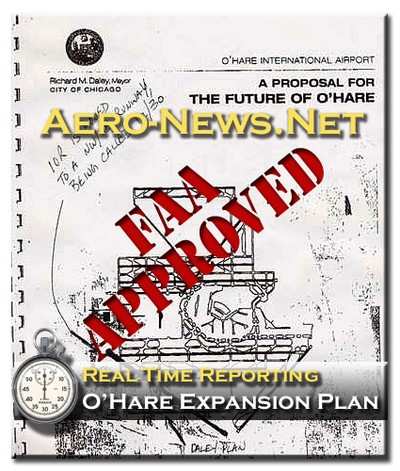That was great, Dave Watrous, thank you. And good morning,
everyone.
As stakeholders in our NextGen effort, you'll be glad to hear
that today we're pulling off the wraps on how our transition is all
going to come about.
Yes, a little later this afternoon, the new OEP -- the
Operational Evolution Partnership, as it's now called -- will be
out on the street, and I'm very excited about it. It'll be our
guide to achieving the vision set forth by the JPDO.
The FAA is already using the new OEP. We've got a cross-agency
team of executives who have been working to align our fiscal '09
budget requests as they relate to the framework you'll see
today.
For the first time, it'll give you a good, hard look at our
integrated plan for the future and how we'll implement the FAA's
commitments in the transition to NextGen. Think of it as our
pipeline to tomorrow.
No doubt by now you've already heard of the
progress the JPDO's making. The new ConOps is up on the website for
public comment. The final version should be out by mid-May, about
the same time as the Enterprise Architecture.
What makes this endeavor so different from the original
Operational Evolution Plan is that we're looking much further out
into the future. Instead of limiting ourselves to ten years, the
new OEP takes us all the way out to 2025.
And it will encompass all of the FAA's commitments to the Next
Generation system, not just capacity.
As you know, the original OEP was almost exclusively focused on
building capacity at the 35 busiest airports through a variety of
measures like RNP, the Airspace Flow Program and new runways. And
it has worked well, I'd have to say.
Since 1999, thirteen runways have opened at some of those big
facilities, including Logan and Hartsfield in just the last year
alone. All told, those 13 have the potential to handle as many as
1.6 million more operations a year.
But we're not done
yet.
Through 2011, we've got eight projects scheduled at six
airports. That's five new runways, plus two extensions at Philly
and O'Hare, and a reconfig at LAX.
Yes, there is a reason that industry has such confidence in the
OEP as an organizational framework that delivers. We're
capitalizing on its success by expanding our scope beyond the big
35 to include 15 metropolitan areas that'll experience substantial
growth by 2025.

We're developing cross-agency plans for implementing an
integrated set of air traffic control capabilities. We've organized
these capabilities into seven major solution sets that will help
you understand where our major areas of focus are. They include
trajectory-based operations, collaborative ATM, and reducing
weather impacts.
The new OEP is, as its name makes clear, all about a
partnership, between the FAA, with you, the aviation community, the
JPDO, and other federal agencies. As it evolves, it'll tell us
where we need to go, and more importantly, how you can help us get
there.
This endeavor can't succeed without industry's input, and
parallel commitments.
And I want to take a moment to pause here and thank Dave and the
RTCA for everything they're doing to make it all a reality.
I also want to single out Tim Rainey and the members of the
ATMAC for those investment recommendations in support of the OEP
and NextGen.
You know, when you look back at the FAA's successes, it's hard
to imagine a time when the ATMAC and its predecessors somehow
weren't involved.
 Over the years, they've
provided advice on issues such as area navigation, time-based
metering, and surface traffic management. Their recommendations
have had the added benefit of helping us save money and operate
more efficiently, two things we weren't exactly known for back in
the day.
Over the years, they've
provided advice on issues such as area navigation, time-based
metering, and surface traffic management. Their recommendations
have had the added benefit of helping us save money and operate
more efficiently, two things we weren't exactly known for back in
the day.
But now, 100 percent of our major capital projects are on time
and within budget, and we're saving the taxpayer millions through
service and facility consolidations, collocations, and other
measures.
We can now track where every dollar is spent, using our new
financial systems like Delphi and cost accounting, and we're
getting good marks from GAO and the Inspector General on our
efforts to increase transparency.
I mention this latter point because in developing our cost
accounting system, we've made sure that the system can support user
fees, which will help pay for NextGen.
Now that we've got our financial house in order, let's talk
price tag.
At the moment, our best estimate for NextGen is in the range of
$15 to $22 billion between now and 2025. The cost to stakeholders
to equip is expected to be almost as much.
But listen, if you think that's a lot of money, imagine for a
moment how high it'll be if we don't prepare for tomorrow.
According to one study, today's tab for commercial passenger delays
stands at $9.4 billion a year. That could soar as high as $20
billion by 2025.
I think the choice is clear. We can pay now, or we can pay
dearly later.
The business case for NextGen is based not only on greater
capacity, even better safety and much improved environmental
impacts. It's also based on driving down the unit costs of
flying.
Our estimates for NextGen -- and I stress they're just that,
estimates -- track pretty closely with what the Europeans are doing
across the pond with SESAR, which they've pegged at $25 to $37
billion.
Now recently, the EU announced the creation of a new body to
develop SESAR, starting as early as next year. Development is
expected to cost the equivalent of $400 million U.S. dollars a
year, which they've committed to spending. The rest of the money
will come from industry and so-called partner states.
As ambitious as our effort sounds, the concern that I have is
that we're risking our ability to pay for NextGen unless the FAA
has a stable, reliable funding source.
Our financial reform bill that's before lawmakers on the Hill is
designed to keep the system safe and efficient, and to provide the
technology and financing to make it happen.

The President's budget for fiscal '08 includes $4.6 billion for
NextGen investments over the next five years. This will gradually
increase the FAA's capital spending from less than $2.5 billion in
'08 to $3.5 billion by 2012.
For those of you keeping score, that's a 40 percent increase --
a clear sign if ever there was one of the Administration's
commitment.
Let's break that down a bit. Spending on SWIM
rises from $21 million to $52 million, while NAS-wide
implementation of ADS-B goes from $86 million to $156 million in
2011.
A couple more numbers to throw out at you. The budget projects a
corresponding increase in our R&D budget, from $140 million in
2008 to almost $200 million in 2009 and beyond.
That's a lot of dollar signs to keep track of, but it just goes
to show how serious we are about NextGen. The flying public
deserves no less.
If you look at the headlines over the last few weeks -- and who
can miss ‘em? -- people might think that flying is all about
stranded passengers, screaming babies, and overflowing toilets.
But I tell you, things are going to get a whole lot worse if we
don't get the sensible, cost-based financing mechanism that's in
our bill. Without that firm foundation of financial stability, the
year-to-year uncertainties of budget and revenues will neutralize
the impact of a long-term plan.
Instead, NextGen will be the solution to a problem that we
anticipated and studied but failed to really address. A legacy of
starts and stops, too little too late.
Before I wrap up, there's one more point I'd like to get across
before I make way for Vicki.
NextGen can't be done by the FAA alone. It's a team effort.
That's spelled out in black and white right there in the new OEP.
The clock is ticking. You and I -- all of us -- must immediately
move together in one direction if we're going to succeed. Thank
you.
 ANN's Daily Aero-Linx (04.15.24)
ANN's Daily Aero-Linx (04.15.24) Classic Aero-TV: 'No Other Options' -- The Israeli Air Force's Danny Shapira
Classic Aero-TV: 'No Other Options' -- The Israeli Air Force's Danny Shapira Aero-News: Quote of the Day (04.15.24)
Aero-News: Quote of the Day (04.15.24) Airborne 04.16.24: RV Update, Affordable Flying Expo, Diamond Lil
Airborne 04.16.24: RV Update, Affordable Flying Expo, Diamond Lil ANN's Daily Aero-Term (04.16.24): Chart Supplement US
ANN's Daily Aero-Term (04.16.24): Chart Supplement US






